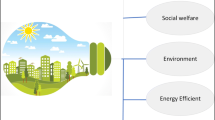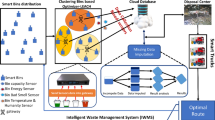Abstract
Noise and air pollution are among the most important problems and challenges in urban environments. Noise can cause several problems in functioning within urban settlements and may result in a variety of health problems. Continuous monitoring, prevention, and active work on solving these problems are in the focus of research communities, local and national agencies and organizations, and many international organizations. Traffic noise on city roads has been identified as one of the major problems in urban settlements. Fortunately, it can be monitored and controlled in a way that can reduce its level and negative effects. One of the most effective and cheapest ways to monitor and control traffic noise is to use wireless sensor networks, IoT technology, and cloud-based architectures. This article presents an approach in designing urban traffic noise monitoring system based on LoRaWAN and microservices oriented architecture supported with open-source hardware and software solutions. Design of the system includes planning LoRaWAN network and development of the IoT system layered architecture. Methods for traffic routing and rerouting in urban areas, based on experiments that uses Dijkstra and Floyd–Warshall algorithms are presented. The system implementation and evaluation of the proposed routing modifications are presented in the case of the city of Zrenjanin in Serbia. Discussion of extensions and improvements of the presented system, as well as future research directions, are also presented.










Similar content being viewed by others
References
Official Gazette of the Republic of Serbia no. 36/2009 and 88/2010. (2010). Law on environmental noise protection. Retrieved from https://www.paragraf.rs/propisi/zakon_o_zastiti_od_buke_u_zivotnoj_sredini.html
European Parliament, Council of the European Union. (2019, September 19). Directive 2002/49/EC of the Eu-ropean Parliament and of the Council of 25 June 2002 relating to the assessment and management of environmental noise—Declaration by the Commission in the Conciliation Committee on the Directive relating to the assessment and management of environmental noise. Official Journal of the European Communities. Retrieved from https://eur-lex.europa.eu/legal-content/EN/LSU/?uri=celex:32002L0049
European Environment Agency. (2014). Noise in Europe 2014 (No. 10/2014) (p. 62). Luksemburg: Publications Office of the European Union. https://doi.org/10.2800/763331
Marouf, S., Bell, M. C., Goodman, P., Namdeo, A., & Neasham, J. (2018). Pervasive wireless sensors: A new monitoring tool for road traffic noise evaluation. Applied Acoustics, 135, 48–59.
Alías, F., & Alsina-Pagès, R. M. (2019). Review of wireless acoustic sensor networks for environmental noise monitoring in smart cities. Journal of Sensors, 2019(1–13), 2019.
Kazmi, A., Tragos, E., & Serrano, M. (2018). Underpinning IoT for road traffic noise management in smart cities. In 2018 IEEE international conference on pervasive computing and communications workshops (PerCom Workshops) (pp. 765–769). Presented at the 2018 IEEE international conference on pervasive computing and communications workshops (PerCom Workshops), Athens. IEEE. https://doi.org/10.1109/PERCOMW.2018.8480142
Wang, C. (2013). Traffic noise monitoring and simulation research in Xiamen City based on the Environmental Internet of Things. The International Journal of Sustainable Development and World Ecology, 20(3), 248–253. https://doi.org/10.1080/13504509.2013.781074
Bai, Y., Li, J., Han, Q., Chen, Y., & Qian, D. (2007). Research on planning and deployment platform for wireless sensor networks. In C. Cérin & K.-C. Li (Eds.), Advances in grid and pervasive computing (pp. 738–743). Springer. https://doi.org/10.1007/978-3-540-72360-8_66
Dobrilović, D., Brtka, V., Jotanović, G., Stojanov, Ž., Jauševac, G., & Malić, M. (2020). Architecture of IoT system for smart monitoring and management of traffic noise. In EAI MMS 2020—5th EAI international conference on management of manufacturing systems. Springer. https://doi.org/10.1007/978-3-030-67241-6
Kapusta, M. (2003). Influence of the intensity and composition of traffic flow on the equivalent noise level. Slovak Journal of Civil Engineering, 2, 35–40.
Jotanovic, G., Brtka, V., Curguz, Z., Stojcic, M., & Eremija, M. (2018). Mobile applications for recording road traffic noise (Vol. 8, pp. 94–98). Presented at the Proceedings/8th international conference on applied internet and information technologies, “St Kliment Ohridski” University-Bitola.
Xu, Y., Zhu, Y., & Qin, Z. (2019). Urban noise mapping with a crowd sensing system. Wireless Networks, 25(5), 2351–2364. https://doi.org/10.1007/s11276-018-1663-x
Patil, P. (2017). Smart IoT based system for vehicle noise and pollution monitoring. In International conference on trends in electronics and informatics (pp. 322–326). Presented at the ICEI 2017, Tirunelveli, India. IEEE.
Socoró, J., Alías, F., & Alsina-Pagès, R. (2017). An anomalous noise events detector for dynamic road traffic noise mapping in real-life urban and suburban environments. Sensors, 17(10), 2323. https://doi.org/10.3390/s17102323
Dobrilović, D. (2018). Networking technologies for smart cities: An overview. Interdisciplinary Description of Complex Systems, 16(3-A), 408–416.
Kamienski, C., Ratusznei, J., Trindade, A., & Cavalcanti, D. (2020). Profiling of a large-scale municipal wire-less network. Wireless Networks, 26(7), 5223–5253. https://doi.org/10.1007/s11276-020-02390-4
Kwon, Y. W., Lee, W. J., & Kim, H. S. (2010). PRIDE: Parameter refinement after initial deployment in wireless sensor networks. In 2010 proceedings of the 5th international conference on ubiquitous information technologies and applications (pp. 1–5). Presented at the 2010 proceedings of the 5th international conference on ubiquitous information technologies and applications. https://doi.org/10.1109/ICUT.2010.5677891
TchuaniTchakonté, D., Simeu, E., & Tchuente, M. (2020). Lifetime optimization of wireless sensor networks with sleep mode energy consumption of sensor nodes. Wireless Networks, 26(1), 91–100. https://doi.org/10.1007/s11276-018-1783-3
Haxhibeqiri, J., De Poorter, E., Moerman, I., & Hoebeke, J. (2018). A survey of LoRaWAN for IoT: From technology to application. Sensors (Basel, Switzerland), 18(11), 3995. https://doi.org/10.3390/s18113995
Chen, X.-Y., & Jin, Z.-G. (2012). Research on key technology and applications for internet of things. Physics Procedia, 33, 561–566.
Bezerra, N. S., Åhlund, C., Saguna, S., & de Sousa, V. A. (2019). Propagation model evaluation for LoRaWAN: Planning tool versus real case scenario. In 2019 IEEE 5th World Forum on Internet of Things (WF-IoT) (pp. 1–6). Presented at the 2019 IEEE 5th World Forum on Internet of Things (WF-IoT). https://doi.org/10.1109/WF-IoT.2019.8767299
Cesana, M., Redondi, A., & Ortìn, J. (2018). A framework for planning LoRaWan networks. In 2018 IEEE 29th annual international symposium on personal, indoor and mobile radio communications (PIMRC) (pp. 1–7). Presented at the 2018 IEEE 29th annual international symposium on personal, indoor and mobile radio communications (PIMRC). https://doi.org/10.1109/PIMRC.2018.8580875
Jaime, J., Sousa, I., Queluz, M. P., & Rodrigues, A. (2018). Planning a smart city sensor network based on LoRaWAN Technology. In 2018 21st international symposium on wireless personal multimedia communications (WPMC) (pp. 35–40). Presented at the 2018 21st international symposium on wireless personal multimedia communications (WPMC). https://doi.org/10.1109/WPMC.2018.8713146
Sethi, P., & Sarangi, S. R. (2017). Internet of things: Architectures, protocols, and applications. Journal of Electrical and Computer Engineering, 2017, 1–25.
Mashal, I., Alsaryrah, O., Chung, T.-Y., Yang, C.-Z., Kuo, W.-H., & Agrawal, D. P. (2015). Choices for interaction with things on Internet and underlying issues. Ad Hoc Networks, 28, 68–90.
Official Gazette of the Republic of Serbia no. 66/91 and 72/2010. (2010). Ordinance on permissible noise level in the environment.
Yusri, A., & Nashiruddin, M. I. (2020). LORAWAN internet of things network planning for smart metering services. In 2020 8th international conference on information and communication technology (ICoICT) (pp. 1–6). Presented at the 2020 8th international conference on information and communication technology (ICoICT). https://doi.org/10.1109/ICoICT49345.2020.9166455
Dobrilović, D., Malić, M., Malić, D., & Sladojević, S. (2017). Analyses and optimization of Lee propagation model for LoRa 868 MHz network deployments in urban areas. Journal of Engineering Management and Competitiveness, 7(1), 55–62.
Semtech. (2017). Lora-net/packet_forwarder. C, LoRa®. Retrieved from https://github.com/Lora-net/packet_forwarder
ChirpStack. (2020). ChirpStack open-source LoRaWAN® Network Server. Retrieved December 12, 2020, from https://www.chirpstack.io/
Eclipse Mosquitto. (2018, January 8). Eclipse Mosquitto. Retrieved December 12, 2020, from https://mosquitto.org/
MongoDB. (2020). The most popular database for modern apps. MongoDB. Retrieved December 12, 2020, from https://www.mongodb.com
Google maps. (2020). Retrieved December 12, 2020, from https://www.google.com/maps/@45.3757591,20.3638952,15z?hl=sr
Lee, B. G., Park, D., & Seo, H. (2009). Wireless communications resource management. Wiley.
Erunkulu, O. O., Zungeru, A. M., Lebekwe, C. K., & Chuma, J. M. (2020). Cellular communications coverage prediction techniques: A survey and comparison. IEEE Access, 8, 113052–113077.
Rappaport, T. S. (2002). Wireless communications: principles and practice (Vol. 2). Prentice Hall.
Seybold, J. S. (2005). Introduction to RF propagation. Wiley.
Milanovic, J., Rimac-Drlje, S., & Bejuk, K. (2007). Comparison of propagation models accuracy for WiMAX on 3.5 GHz (pp. 111–114). Presented at the 2007 14th IEEE international conference on electronics, circuits and systems, IEEE.
Jha, C. K., & Jain, R. (2014). Literature survey on various outdoor propagation model for fixed wireless network. International Journal of Science and Research, 3(8), 2012–2015.
Simić, I., Stanić I., & Zrnić B. (2001). Minimax LS algorithm for automatic propagation model tuning. Pre-sented at the proceeding of the 9th telecommunications forum (TELFOR 2001), Belgrade.
Abhayawardhana, V. S., Wassell, I. J., Crosby, D., Sellars, M. P., & Brown, M. G. (2005). Comparison of empirical propagation path loss models for fixed wireless access systems. In 2005 IEEE 61st vehicular technology conference (Vol. 1, pp. 73–77). Stockholm. https://doi.org/10.1109/VETECS.2005.1543252
Dobrilović, D., Tokody, D., Stojanov, Ž., & Malić, M. (2019). Exploring LoRa technology application in smart cities. In Proceedings of 9th international conference applied internet and information technologies (pp. 181–186). Presented at the AIIT 2019, Zrenjanin, Republic of Serbia. University of Novi Sad, Technical faculty “Mihajlo Pupin” Zrenjanin, Republic of Serbia.
Aref, M., & Sikora, A. (2014). Free space range measurements with Semtech LoRaTM technology. In 2014 2nd international symposium on wireless systems within the conferences on intelligent data acquisition and advanced computing systems (pp. 19–23). Offenburg: IEEE. https://doi.org/10.1109/IDAACS-SWS.2014.6954616
Jörke, P., Böcker, S., Liedmann, F., & Wietfeld, C. (2017). Urban channel models for smart city IoT-networks based on empirical measurements of LoRa-links at 433 and 868 MHz. In 2017 IEEE 28th annual international symposium on personal, indoor, and mobile radio communications (pp. 1–6). Presented at the PIMRC, Montreal, QC: IEEE. https://doi.org/10.1109/PIMRC.2017.8292708
The Things Network. (2020, November 24). RAK2245 Pi Hat Edition - LoRaWAN® Gateway concentrator module. The Things Network. Retrieved December 12, 2020, from https://www.thethingsnetwork.org/docs/gateways/rak2245/
Semtech. (2020). SX1301 | Digital Baseband Chip LoRaWAN macro gateways | Semtech. SX1301 Digital Baseband Chip for outdoor LoRaWAN® macro gateways. Retrieved December 12, 2020, from https://www.semtech.com/products/wireless-rf/lora-gateways/sx1301
Microchip. (2020). RN2483—Wireless modules. Retrieved December 12, 2020, from https://www.microchip.com/wwwproducts/en/RN2483
Escudero, L. F., & Muñoz, S. (2016). A survey-based approach for designing the lines of a rapid transit network. In LAGOS’13: Seventh Latin-American algorithms, graphs, and optimization symposium, Playa del Carmen, México—2013 (vol. 210, pp. 14–34). https://doi.org/10.1016/j.dam.2015.11.006
Floyd, R. W. (1962). Algorithm 97: shortest path. Communications of the ACM, 5(6), 345.
Anderson, J. A. (2004). Discrete mathematics with combinatorics. Pearson Education Inc.
Warshall, S. (1962). A theorem on boolean matrices. Journal of ACM, 9(1), 11–12.
Aini, A., & Salehipour, A. (2012). Speeding up the Floyd–Warshall algorithm for the cycled shortest path problem. Applied Mathematics Letters, 25(1), 1–5. https://doi.org/10.1016/j.aml.2011.06.008
Pereira Junior, D., & Wille, E. C. G. (2018). FB-APSP: A new efficient algorithm for computing all-pairs shortest-paths. Journal of Network and Computer Applications, 121, 33–43. https://doi.org/10.1016/j.jnca.2018.07.014
Cox, T., & Thulasiraman, P. (2017). A zone-based traffic assignment algorithm for scalable congestion reduction. SI: Intelligent Transportation Communication Systems, 3(4), 204–208. https://doi.org/10.1016/j.icte.2017.11.003
Author information
Authors and Affiliations
Corresponding author
Additional information
Publisher's Note
Springer Nature remains neutral with regard to jurisdictional claims in published maps and institutional affiliations.
Rights and permissions
About this article
Cite this article
Dobrilović, D., Brtka, V., Jotanović, G. et al. The urban traffic noise monitoring system based on LoRaWAN technology. Wireless Netw 28, 441–458 (2022). https://doi.org/10.1007/s11276-021-02586-2
Accepted:
Published:
Issue Date:
DOI: https://doi.org/10.1007/s11276-021-02586-2




